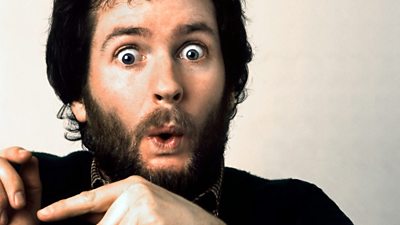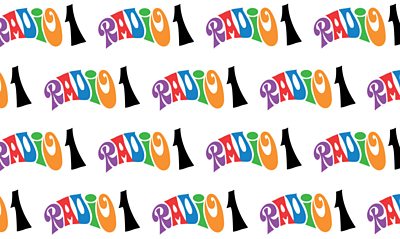Love-ins at Woburn and San Francisco, the devaluation of Sterling, the Monkees and the Maharishi, and the beginning of the 'exciting new sound of wonderful Radio 1'. Our timeline explores the highs and lows of the station that rocked the nation.
1967: Radio 1 opens
Welcome to the exciting new sound of Radio One.
Tony Blackburn spins the first discs
Tony Blackburn opened Radio 1 on 30 September 1967 at 7.00am, with Robin Scott, then Controller Radio 1, standing over him!
The station set out with a blank sheet of paper to create a new style of radio, a ‘DJ style’, by that time heard only on the pirate radio stations, which had recently been forced to close.
Blackburn played "Flowers in the Rain" by The Move as the first track. On air next was Leslie Crowther of Crackerjack fame, then a five minute quiz with Duncan Johnson. The next big music show of the morning was a lively mix of tracks with Keith Skues, who can still be heard on air, late night on local radio.
1967: John Peel
John Peel: the anti-establishment voice with the OBE
John Robert Parker Ravenscroft OBE, otherwise known as John Peel, was not just a Radio 1 DJ, he was also a record producer, and lover of Eurovision.
As the longest serving of the original ±«Óãtv Radio 1 DJs, his time at the station was hugely varied. He was the first to play psychedelic rock, was always willing to try out new bands never before played on the radio on his "Peel sessions" programmes, he loved Star Wars memorabilia, football fanzines, and amassed a vast collection of vinyl LPs.
-
John Peel Ken Garner looks at his legacy for the 100 Voices project
-
-
Radio 1 tribute
1967: Kenny Everett

Anarchy comes to Radio 1 – Kenny Everett takes to the air
Pirate station Radio London was Kenny Everett’s first broadcasting ‘home’ where anything went, and anarchy ruled.
Broadcasting from a ship moored in the North Sea, Everett’s crazy sense of humour was heard from day one in 1964, but by 1967 the pirates had been shut down and Everett was snapped up by the new Radio 1.
Nothing would reign him in, and ±«Óãtv management was never quite sure what he might do next. Hugely creative, Everett sung all his own ‘jingles’, and invented a raft of fictional on-air characters including the hilarious ‘Lobelia’ May.
-
Sue Lawley's castaway is DJ Kenny Everett, 18 March 1994
-
Great Lives: Kenny Everett Chris Tarrant nominates Kenny Everett as the greatest pioneer of modern radio.
1970: Annie Nightingale
Annie Nightingale: a first for women on air
Radio 1 opened with an entirely male line up of presenters. Women were nowhere to be seen until 1969 when Annie Nightingale shook up the station.
The original remit of Radio 1 was to serve housewives, providing ‘husband substitutes’ through its middle of the road pop presenters. But Annie Nightingale fought the sexist attitudes hard, and after working in the music press she was well placed to get on air – bit it was no easy task.
Her first broadcast appearance was actually on TV in 1963 when she appeared on the panel of Juke Box Jury; her first Radio 1 show was on Sunday evenings.
-
Pioneering Women: Annie Nightingale Annie Nightingale's story at the 100 Voices project
-
±«Óãtv Programme page
-
Newsnight with Annie Nightingale Annie takes over Newsnight for a special bass bulletin and weather report
1973: The Roadshow
The Roadshow comes to town
23 July 1973 saw the first Radio 1 Roadshow. The station arrived in Newquay, and then toured across more than 50 venues a year until 1999.
The DJ’s would play a live set, meet local people, give away those much desired "goodie bags" and run competitions. The Roadshow was designed to take the station to the listeners, and get out of the studios in London.
The DJs were also accompanied by regular ‘crew’. “Smiley Miley", aka Tony Miles, was a well-known member and had provided one of the original Roadshow caravans. 1992 saw numbers at the Roadshow peak when 100,000 turned up for the 25th anniversary of the Radio 1.
-
Footage of when the Radio 1 Roadshow came to Poole in 1974. Featuring DJ Emperor Rosko.
-
1973: Let’s Get This Show on The Roadshow Tour Manager Richard Greaves relives a day in the life of the Radio 1 Roadshow.
1980: Our Tune
Simon Bates – Our Tune
For over 30 years Our Tune, that poignant feature of love and loss, captured the UK’s imagination.
The concept was simple. Listeners wrote in with a real life love story or tragedy, and Simon Bates would read it on air, mustering all the sympathy he could whilst the theme to Franco Zeffirelli's 1968 film Romeo and Juliet played in the background.
The item was so popular many of the stories were published in a book, and when Bates left Radio 1, he took Our Tune with him, revived it for his show on Atlantic 252, and brought it to television as part of Good Morning with Anne and Nick in 1994–95.
1984: Relax banned
Frankie Goes to Hollywood's 'Relax' is banned
"Relax" by Frankie Goes to Hollywood was banned by Radio 1 because of its sexual references. Mike Read refused to play it, and an official ban followed.
Curiously "Relax" had been played 90 times on Radio 1 and even featured on Top of the Pops before being banned. But following Mike Read’s decision, only the title of the track could be mentioned in the chart rundown, and the song was not played.
At the time Radio 1 Controller Derek Chinnery said the lyrics referred to ‘sexual aberrations’, ‘not exactly subjects which I think are appropriate for broadcasting on the radio’.
1984: Ranking Miss P
Black, female and proud! The Ranking Miss P on the ±«Óãtv
The Ranking Miss P (aka Margaret Anderson) was the first black female DJ on Radio 1.
Her first venture into radio was with the Dread Broadcasting Corporation – a pirate station, the first in Europe run by the African-Caribbean community. After voicing trails for the ±«Óãtv TV programme Ebony, and her own series on the ±«Óãtv World Service, she guest presented for Janice Long on Radio 1.
By 1985 she was presenting her own reggae show - Culture Rock, every Sunday. This was the first time the music got a regular slot on the ±«Óãtv, despite it emerging onto the scene in the late 1960s.
-
Facebook
1991: Radio 1 - 24/7
It seems unimaginable now, but as recently as 1991, Radio 1 could still only be heard on AM in some parts of the country.
A common complaint was that Radio 1 was difficult to hear on AM, especially at night, so from 1987 a new FM service gradually began to be developed. 4 years on, and with the FM network nearly complete, an overnight service was also launched. Well established voices Bob Harris and Andy Peebles covered the extra hours during the week, and newcomer Neale James from commercial and local radio, could be heard at the weekends. By 1995 Radio 1 was the first to go digital, launching on DAB that Autumn.
1993: All change for the 90s
Matthew Bannister Radio 1 Controller from 93-98, was famous for attracting a completely new audience to the station.
Bannister arrived with a remit to radically shake up Radio 1. The station had kept its loyal audience since the 1960s, but by 1993, the output was thought to sound old, tired and worn out. Bannister terminated the contracts of 8 of the longest serving DJ’s and banned any music recorded before 1990 from being played. New DJ’s were added, and the station started to attract a newer younger audience, but the shift to a new order was painful. The DJ’s in jokes were out, as the cool 90s progressed.
-
±«Óãtv World Service
April 1995 was Chris Evan’s debut on Radio 1. Sitting in the Breakfast Show hot seat, he turned the programme upside down.
His early morning slot was packed with innuendo which for many critics went too far. He encouraged two female guests to perform a strip show live on the programme, and humiliated some of his team on air, two examples from a list of edgy items. After a tasteless joke about holocaust victim Anne Frank, a string of complaints followed. In January 1997 he asked for a four day week, sparing Fridays to work on his Channel 4 TV show. ±«Óãtv management rejected this and he left the station.
-
±«Óãtv Press Release
2017: Greg James
Fast forward to the future
A celebration of Radio 1’s history in its 50th year takes the shape of an all-new pop up station Radio 1 Vintage, but what about Radio 1’s future?
With young people using a huge variety of music apps, and creating their own music streams to share, what keeps them loyal to Radio 1 in 2017? It must be the presenters. However, finding them is getting difficult. Reality TV stars aren’t committed to radio, and YouTubers might have a big following but the big money is elsewhere. Is student radio the new breeding ground for Radio 1’s next generation of on-air talent? Greg James has already moved across from student radio, and listeners love him!
-
±«Óãtv Programme page
Radio timelines
-

Radio 1 timeline
Love-ins at Woburn and San Francisco, the devaluation of Sterling, the Monkees and the Maharishi, and the beginning of the 'exciting new sound of wonderful Radio 1’. Our timeline explores the highs and lows of the station that rocked the nation. -

Radio 2 timeline
How Radio 2 became the station we hear today via soothing instrumental light music, middle of the road classics, and a weekly soap opera. -

Radio 3 timeline
From Weber, Bartok and Bach, to jazz, the avant-garde and world music, drama, prog rock and sport - Radio 3 has always been full of surprises. -

Radio 4 timeline
To see the world differently, listen - how Radio 4 reinvented itself from the ±«Óãtv Service.
